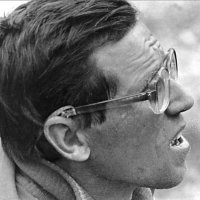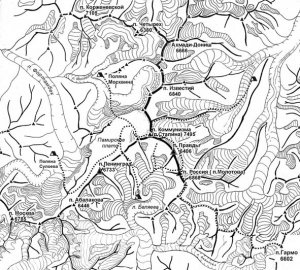|
Author: Igor Stepanov, Sankt-Petersburg
39 Ascents to the Peak of Communism Made for the First Time
Part 1.

Author
|
The article is dedicated to the 70 th anniversary of storm of the peak “ 7495” .
The author undertook to write this article at the instance of the editor-in-chief of the third volume of the book “Alpinists of the Northern Capital” - German Andreev. I have been to this wonderful summit six times, each time I passed different route, along different side of the Mount. There is the history of my relations with this Peak:
Years 1974-1975. Those years I didn't manage to reach the top of the peak. Two attempts to climb to the top along the center of South-Eastern Wall from the glacier of Beliaev made by the team of F. Gitenev (Sankt-Petersburg's “Burevestnik”) fizzled out. We climbed up to the points 5900 and 6200 (“Bird”) and each time had to descent because of necessity of rescue operations – once we had to attend our younger colleagues, suffering distress on the route of V. Nekrasov, the next time it was necessary to down Jury Krasnouhov, who was bitten by stones, when nine people were waiting for him at the last rope.
1976 – together with O. Galkin and B. Gavrilov from the glacier Fortambek (along the edge of “Burevestnik”) I reached the top fort the first time.
1978 – from the glacier of Walter along the route of N. Cherny together with B. Studenin, J. Marchenko and A. Shindjaikin.
1980 – from the glacier of Beliaev (the route of V. Nevorotin of the 6 th grade of difficulty), the second passing the route together with B. Studenin and G. Petrashko.
1982 – from the glacier of Walter along the route of J. Borodin in two-man team with J. Borzov.
1983 – from the glacier Fortambek along the route of I. Getman (second passing) as a leader together with J. Borzov and J. Borodkin.
1988 – from the glacier Bivachny (Ordzhonikidze) along the route of E. Abalakov as a leader together with A. Golovin, S. Dusheiko, S. Ionenkov and O. Shkanova.
And just now, when I imagine all 39 routes to this summit passed for the first time, I understand how difficult my task is. It seems to me that the editor-in-chief had to persuade V. Shopin to write this article, I hat to him for his two extremely difficult ascents to the Peak of Communism : in 1981 – along the South-Western wall under the direction of V. Solonnikov together with V. Baliberdin, both of them had attended expedition “Everest- 1982” , and in 1986 – the first winter ascent to the Peak of Communism again with V. Baliberdin.
But as they charged me with this task I will try to finish this article. I am going to describe the history of exploring of this highest summit of the country and three tens and more of routes that had been made from the year 1933 till our days. Fourteen from these routes won the Championships of USSR, and four teams from this list were from Sankt-Petersburg.
Some words about the history of exploring the Peak “ 7495”.

Map from above.
|
The exact altitude of the summit was defined in 1928 by the Pamir expedition of the Academy of USSR (German geodesist R. Finstervald). As inhabitants and previous expeditions considered the Peak Garmo to be the highest point of the Northern-Western Pamir, German geodesists named the peak 7495 as “Peak Garmo”. This prolonged mishmash with these two summits and gave rise to the puzzle of the “junction of Garmo”, that was solved up to the end only in 1932.
During the period 1928-1933 Pamir-Tajik expedition explored “blank spots” in the Pamir in the region of the ridges of Academy and of Peter the first, including all the region of the glacier of Fedchenko. In 1932 by three expedition groups under the direction of N. Krilenko , N. Gorbunov and I. Dorofeev, the “problem of Garmo” was solved. The group under the direction of Krilenko ascended to the ridge of Academy from the glacier Garmo and to the shoulder of the real Peak Garmo, the group leading by Gorbunov explored the region of the Peak 7495 from the East, from the glacier Bivachny, the group of Dorofeev penetrated to the region of the glacier Fortambek and the glacier of Walter. Geodesic intersections made by the groups showed that the Peak Garmo and the peak 7495 were two different summits, remote for 20 km from each other. Real Peak Garmo was located at the turn of the ridge of Academy and Darvazarsky ridge, and the peak 7945 was located at the turn of the ridge of Academy and the ridge of Peter the first. It was an outstanding geographical discovery, when the highest point if the Pamir was mapped exactly.
Conquering the peak “ 7495”
|
From North-East.
1. Abalakov, 3, Eastern edge.
1a. – modern variant of start of the route of Abalakov.
2. Tamm, 61, Southern ridge from the glacier Bivachny.
3. Kustovsky, 67, South-Eastern ridge.
4. Budanov, 68, Eastern counterfort.
5. Voronin, 70, North-Eastern counterfort.
6. Borisenok, 72, left edging of the North-Eastern wall from the glacier Ordzhonikidze.
7. Chunovkin, 78, North-Eastern wall.
8. Putintcev, 78, North-Eastern wall.
9. Luniakov, 87, left South-eastern counterfort
|
1932. At the end of field season an attempt of ascent to the peak “ 7495” along the eastern edge from the glacier Bivachny was made. According to different sources (D. Zatulovsky, I. Dorofeev, E. Beletsky ) the group under the direction of Gorbunov managed to climb up to the altitude from 5600 to 6200 m . Probably, they managed to pass first two simple rocky outcrops (from six located on the ridge), in other words, up to the altitude 5800.
1933. August. Six alpinists under the direction of N. Gorbunov went to make an ascent to the summit, among them there were: E. Abalakov, D. Guschin, A. Getie, J. Shijanov, and A. Harlampiev. But not everything was all right. When passing the second rocky outcrop young president of Moscow Mountain section N. Nikolaev fell down and perished, at the altitude 5600 D. Irakle from auxiliary group fell ill. He was downed to the glacier, but, in spite of the efforts of doctors, he died in the glacier camp at 4500. With great difficulties all six rocky outcrops were passed. D. Guschin, J. Shianov also fell ill and from the altitude 6900 went down. Thus, only three alpinists remained on the route. Prolonged bad weather disabled A. Getie, he refused the further ascent (Getie fell seriously ill). On the third of September two alpinists – E. Abalakov and N. Gorbunov went up. E. Abalakov was younger and stronger, he went forward and reached the top alone. N. Gorbunov stopped under the apical climb, at the altitude about 7400 m . In such a way the highest point of the country was conquered. It was done, to put it mildly, at the breaking point of men possibilities of all the participants of the storm group, and, if the auxiliary group leading by A. Tsak didn't help the alpinists on their descent from the point 6400 – nobody knew, how the storm could end. According to the suggestion of the members of the expedition the summit was named the Peak of I. Stalin . (The summit was named the Peak of summit before that ascent – in winter 1932 – see the book “Alpinists of the northern Capital”, second volume).
1937. The second ascent to the Peak of Stalin . The leader of the storm was talented Moscow alpinist O. Aristov. Among the members of the group – E. Beletsky , L. Barshah, N. Gusak, V. Kirkorov and the doctor I. Fedorkov. On the thirteenth of September O. Aristov fell down and perished at the altitude 7495, the other members of the team climbed to the top. Rough apical ridge they passed without crampons, that, probably, caused the fall and death of O. Aristov.
To be continued…
|



 При вводе Логина и Пароля,
При вводе Логина и Пароля,




 При вводе Логина и Пароля,
При вводе Логина и Пароля,

